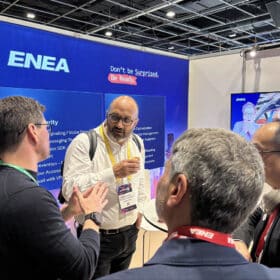Amazon and Deutsche Telekom join Enea to discuss the race between telcos and webscalers
Enea recently took part in a panel discussion with ABI Research that examined the race between telcos and webscalers, or hyperscalers, for 5G edge computing. Currently, webscale players are taking advantage of their lean operations and global presence to build capabilities that have the potential to compete against telco operators. As such, webscalers are pursuing new value creation in 5G and edge computing, despite them not necessarily having the penetration or last mile connectivity such as Radio networks, which is the forte of communication service provider (CSP) networks.
When considering a technology ecosystem for 5G and edge computing, there are multiple technological components involved. These components include compute and networking infrastructure, data collection devices, low latency and high bandwidth connectivity. Additionally, there is artificial intelligence (AI), machine learning (ML) and a cloud data management (CDM) layer that stitches everything together.
It is important to understand how these components are integrated, as well as how to collaborate and co-create to simplify the ecosystem. Following are some of the key points from our discussion.
Why is edge computing such an important value proposition to the enterprise domain?
Edge computing is critical to support the multitude of applications – especially, latency-sensitive applications. For instance, with augmented and virtual reality (AR/VR), cloud gaming, automated transportation and drones, it is critical to be within a certain millisecond bandwidth for an acceptable user experience. That light can cover 100km in 1ms is a basic law of physics that creates latency. An application, such as connected cars requires communication between peers to share traffic information and needs mobile edge computing to work within its latency budget.
Why is it important to collaborate with operators as they bring services to enterprise domain?
One of the challenges at the edge is that most applications require state or data such as subscriber or session data to function effectively. Enea Openwave has partnered with Deutsche Telekom to manage and federate such data – not only across core data centers but also to distribute and manage at the edge, where the infrastructure or footprint is much smaller.
For example, if an enterprise is the end customer for an application, can you simply have data for that enterprise data sitting at that edge site closest to the enterprise. In other words, all aspects of the enterprise data management such as data replication, data synchronization, failover, recover in cases of HW or networking failure is all handled by a common data layer. But at the same time, that data layer at the edge can talk back to the core for certain aspects of the data, such as control plane data. The control plane and management data can be managed centrally, while all the enterprise data remains localized at the edge and the edge applications remain stateless for privacy and security purposes.
Also, interestingly for the first time in 5G a common network data layer (NDL), or common data layer, has been defined as part of the 3GPP standards. This NDL keeps the application simple and stateless in the edge so data can be appropriately federated and distributed without sacrificing availability, privacy or security. I think that is critical.
In terms of collaborating, telcos have clear strengths around connectivity and networking, while webscalers understand how to be agile, innovative and software driven. It is through collaboration that these two very different skillsets combine to compliment each other beautifully.
In an ideal world, how would webscalers and technology providers co-create services with telecom operators to support vertical customers?
5G is the first generation of telecom service which will truly be deployed in the cloud. For the first time, telcos are operating and focusing primarily on the software layer in terms of applications. Traditionally, Telco applications were running on appliances or purpose-built hardware, but that’s all been replaced by a cloud-native environment where applications will run in containers with a common resource orchestrator such as Kubernetes. 5G also supports a service-based architecture in the core, with interworking based on REST-based APIs. The cloud native and API based approach combined with the increased capability of 5G networks in terms of throughput and latency makes it easier for telcos and webscalers to collaborate and co-create services on a common edge platform for different verticals like healthcare or transportation etc.
There often is tension in organizations between leveraging existing generations of technologies and operationalizing the new technologies, such as 5G and edge computing. How do you manage that to pursue new value creation in enterprise verticals and introduce/roll out new tech?
It’s important to understand that the edge cloud will be far more heterogenous than large core data centers currently managed by the large cloud players. The applications running on the edge will also be a complex mix of 4G and 5G Applications.
A good example of such is TCP Acceleration. We work closely with operators on transmission control protocol (TCP) acceleration to reduce user perception of latency from an application standpoint. With 5G and edge the same application now has to deal with larger 5G throughputs and dynamic handoffs between 4G and 5G radio networks for mobile users on the move. Connectivity is a major strength for service providers. Therefore it is important that service providers are able to select the edge that is closest to the end users and they are able to dynamically route traffic to the nearest edge whilst taking into account a heterogeneous edge with different networking, virtualization and orchestration stacks.
The strength of webscalers is that they make it easy for application developers to coexist at the edge with the telco. When both parties play to their strengths, it enables them to deliver the best possible value to the end user.
Both telcos and webscalers need to be flexible and innovative in terms of the business model, especially as operators are accustomed to the subscription modal, and hyperscalers use the ad-based model. So while innovation is needed on that front, it’s important for the discussion to start with how to deliver value and measure that value, while also playing to the strengths of both operators and webscalers.




